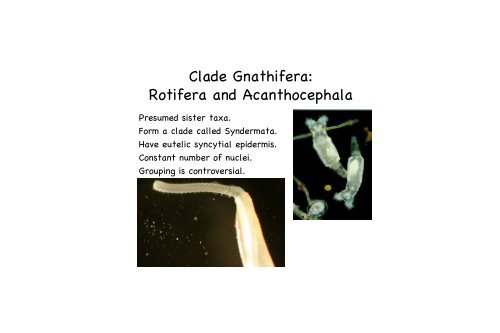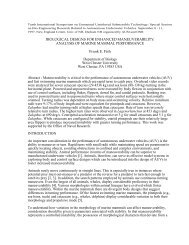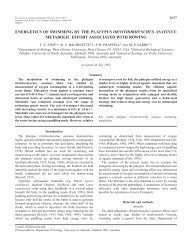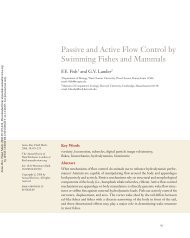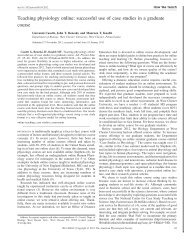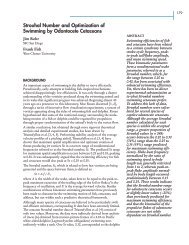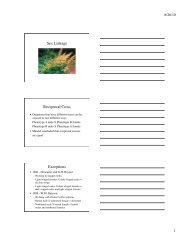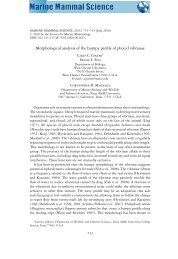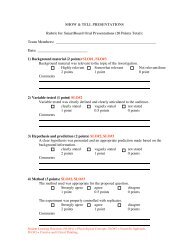Clade Gnathifera: Rotifera and Acanthocephala
Clade Gnathifera: Rotifera and Acanthocephala
Clade Gnathifera: Rotifera and Acanthocephala
You also want an ePaper? Increase the reach of your titles
YUMPU automatically turns print PDFs into web optimized ePapers that Google loves.
<strong>Clade</strong> <strong>Gnathifera</strong>:<strong>Rotifera</strong> <strong>and</strong> <strong>Acanthocephala</strong>Presumed sister taxa.Form a clade called Syndermata.Have eutelic syncytial epidermis.Constant number of nuclei.Grouping is controversial.
Phylum <strong>Rotifera</strong>pseudocoelomatethree embryonic germlayers (triploblastic)marine or freshwater,interstitialfree-livingcomplete digestive system
Lifestyle <strong>and</strong> FormRotifers come in a widerange of colors <strong>and</strong> shapes.– Shapes oftencorrespond to lifestyle(floaters, swimmers,sessile).– They may be individualor colonial.– Mostly freshwater.– Benthic <strong>and</strong> pelagicforms.
Characteristic featureRotifers have a ciliated crown, the corona,characteristic for the phylum.http://www.youtube.com/watch?v=dlIZGYiajWQ&feature=related
General Body PlanDigestive tract a continuous tubeGrinding mastaxToes for attachmenthttp://www.youtube.com/watch?v=49RROi71bbA&NR=1&feature=fvwp
ReproductionDioecious (separate sexes) butsome species parthenogenetic(females produce diploid eggs).Some are parthenogenetic duringpart of the year, depending onenvironmental conditions.Thick shelled eggs that canwithst<strong>and</strong> harsh conditions aresometimes produced.
Phylum <strong>Acanthocephala</strong>All spiny-headed worms are parasites in the intestines ofvertebrates.Over 1100 species known.Occur worldwide <strong>and</strong> parasitize fish, birds, <strong>and</strong> mammals.Larvae develop in crustaceans or insects.
<strong>Acanthocephala</strong>n CharacteristicsNo digestive system,nutrients absorbed acrosstegumentProtonephridia <strong>and</strong> flamecellsCovered in syncitialepidermis w/ giant nucleiNo circulatory/respiratorysystem
Characteristic featureProboscis has rows of recurved spines that penetrate <strong>and</strong>may rupture host intestines.Proboscis with hooks can be inverted into
Parasitic LifestyleRarely parasitize humans.<strong>Acanthocephala</strong>ns penetrate the intestinal wall withspiny proboscis.!Remarkably little inflammation on host wall, butpain of infection is intense.Larval acanthors burrow through beetle intestine.!Develop into juvenile cystacanths in the insecthemocoel.
Phylum Gastrotricha• Gastrotrichs appear similarto rotifers, but withoutthe ciliated corona <strong>and</strong>have a bristly lookingbody.• Members of the phylumGastrotricha arepseudocoelomate <strong>and</strong> havethree embryonic germlayers (triploblastic).• Complete digestive system.• Hermaphroditic orparthenogenetic.


